#there's digital evidence of my thirsting on main for them
Text
STOP I JUST WATCHED THE VIDEO OF MEGLO SHOWING THEIR OUTFITS FOR Z4
#ADDISON'S OUTFIT-#i've been shot dead#she's also lowkey dressed like a trans flag but that's literally not a problem#HER HAIR#they're both so hot#i want them both#i've said this before#there's digital evidence of my thirsting on main for them#and i will CONTINUE#i cannot be stopped#stop her heels are so chunky and high and i want them!#they really said 'we have to make this height difference a little smaller'#i'm literally so excited#zombies#disney zombies#zombies 4#milo manheim#meg donnelly#zed necrodopolis#addison wells#meglo#zeddison#of me***
7 notes
·
View notes
Text
Greed.

GIF credit to @saralou23.
Author’s Note: Here is the next chapter of Flewed Out. Cartel Daddy is also our main man for Smut Sunday. Enjoy, sleazies!
---------------------------------------------------------------------
You stretched like a cat - your arms and legs extended as you let the plush comforter fall to the floor. Fingers of sunlight broke through the drawn curtains as you sat up - jet lag setting in as you rubbed your eyes weakly.
“You’re up.” Miguel’s deep voice sounded like a song to your ears. Your sleepy eyes opened wide to gaze at him, still dripping and wrapped in a towel and you felt your swollen pussy clench at the evidence of his print underneath the loosely wrapped garment.
“Get up. We’re going to the desert today.” Miguel dropped the towel shamelessly - his thick member resting against his thigh as he sauntered into his closet. “Bring extra clothes, because I don’t want to hear your spoiled ass complain if something gets dirty.” His command did little to move you from your snuggled position. Miguel had returned late last night and spent the twilight hours reminding you how much he missed you and your pussy.
“Really?” Miguel emerged - casually dressed in dark jeans and a black t-shirt, adorned with gold jewelry - bracelets, rings, and a Cuban link chain glittering in the morning rays. “Get ya ass up. I’ll have your breakfast waiting.” He roughly jerked the remaining blankets - exposing your naked body to the cool air.
“Oh, and wear something I like.” His request was punctuated with a kiss as he left you to sulk in your sleepy state.
You turned in the large SUV, stretching your legs across Miguel’s thighs, flexing your pedicured toes against his abs. “Do you need something, amor?” His free hand pressed into your arch - pushing against the tight muscle - as he continued to read the financial report in his hand.
Your pussy was throbbing - weeks of missing your lover left you wanton and Miguel’s attention to business left you pouting and bratty. “Hm, what do you want?” His fingers danced across your exposed thigh - leaving goosebumps in their wake. Your pussy spoke for you - grabbing his hand and pulling it to your core, rubbing against his hand - “I want you.” You whined, drawing out the u as you held his wrist tight.
Miguel’s dark laugh filled the tiny space - his dark eyes piercing your resolve as you slowed your hips, freezing against his palm. “Oh mama, do you need it?” He teased as he shifted the paperwork in his lap, slipping the distraction into his bag. You rolled your bottom lip through your teeth as you watched Miguel turn, opening his body to you - “Come here.” His spread legs left his jeans pulled tight - his growing bulge becoming noticeable.
His lips met yours as you moved closer into his spread legs- his tongue sliding around yours, pulling you to him. His hands roamed your body - palming your breasts through your tank top as he bit your lip, bringing a moan from your mouth.
“Turn around.” Daddy was here - his voice dropping as he pulled back - his onyx eyes glazed with lust. You smiled - drunk on knowing that Daddy would take care of you. Your back pressed against his muscular chest, - his gold chains cool against your back as your head lazed against his shoulder. “You’ve been such a good girl.” His words mumbled, onto your skin, slid down your neck and straight to your pussy. You felt your lips wet at his compliment - the determination to be a good girl wrecking your attitude.
His teeth scraped against your skin, pressing into your skin with such a sensual burn, as his hand slid into your tank top, tweaking a nipple between his long fingers. Your eyes fluttered closed as you melted into his body, leaning against him, feeling his chest rise and fall with yours as his hand slid over your shorts, cupping your mound. “Please. I behaved.” Your fingers worked quickly, pushing your shorts down, as Miguel chuckled - his breath hot against your ear.
“Oh mami. I missed you.” The admission was a whisper. Your eyes fluttered open as he turned your chin up - your eyes meeting as he bent low - kissing your forehead with a softness that was new. His hand crept up your side - your body twisting as he tickled - until it rested against your breast, massaging the soft flesh. His hand slid into your shorts - rubbing your clit through your panties - the friction of the panties against your clit relaxing your body.
“Daddy. Touch me. I need it.” You raised your hips - rubbing yourself against his fingers, begging to be filled. “How many do you want?” His lips suctioned to your neck, nipping and sucking, as he peaked your nipple into a harden bud - each sense overwhelming another.
“Daddy. Two. Just do it.” You were breathless. Your panties wet from his tease, drawing out your pleasure for the ultimate release. When Miguel rewarded you, he did it right. He left you greedy for his praise. He rubbed his nose against the shell of your ear as he slid two fingers through your wet lips. His body tensing at the warmness of you. “Oh fuck.” You pushed yourself down - his fingers disappearing in your tight pussy as you pressed your head against his shoulder - clinging to stability. His fingers curled into you - digging into your soft walls as you rolled your hips. As his fingers scissored you, your hips rolled sharply - fucking yourself on his digits.
The sounds of your gushing pussy and your soft moans filled the tight space. The erotic sounds ringing in your ears. “Can I give you one more? You feel so good, baby. Let me fill you up with one more.” He didn’t wait for permission as he pushed a third finger into your dripping slit. “Fuck, Daddy. It’s too tight.” Your body was limp against him as he curled his fingers, calling your orgasm.
“Oh my god. Don’t stop, don’t stop.” You begged as your thighs fell loose - your muscles weak with pleasure. Miguel’s heavy hand held your neck, possessively, owning your body in the moment as his palm pushed against your aching clit with each thrust. “Daddy won’t stop. You deserve to cum. I’ll let my pussy cum.” Even in the most intimate moment, he reminded you who you belonged to as the squelching noise of your swollen lips echoed through the car. In another lifetime, you’d be mortified to be heard, but in this moment, you felt protected - shielded from judgement and taken care - Miguel never letting you forget that the thirst was mutual.
Your head rolled into the crook of his neck as you whimpered, “That’s the spot, isn’t it? Yeah, Daddy knows. Come on, baby girl.” Miguel started at his fingers as your pussy twitched - gripping his fingers as you creamed around his digits, your body dissolving into euphoria as he continued his assault on your throbbing pussy.
Your knees shut - trapping his arm against you - as you tried to slip away from him before you lost yourself completely, but Miguel was greedy and you knew better. His fingers tightened around your throat- feeling your pulse thump under his long fingers. “Ah, don’t do it. Don’t keep it.” His kisses dotted your raised cheek as he rubbed slowly - building you back up with each twirl of his thumb over your pulsing clit. “Good girls want to come for Daddy. Your pussy loves it. Look at her.” He pushed your head, making you watch the erotic show before you - tears pricked your eyes as you gushed - betrayed by your pussy who craved Miguel’s expert touch.
You cried, tears slipping passed your squinted eyes, as Miguel pulled away from you - your walls pulsing at the loss of fullness. He smugly licked them - moaning at your taste. “Dulce. I could eat you all day.” His eyes were hooded as he kissed you sloppily - making you savor yourself. You nuzzled yourself into his frame - your muscles tingly from the high. You felt your heartbeat in your ears as your breathing slowed - your senses filled with Miguel.
“Here, raise up.” He pulled your shorts up - your pussy dripping as he slid your panties over your swollen mound. “You can change when we get to the house.” He whispered as he pulled a blanket over your curled body as you sank deeper into his hold. You breathing slowed as he caressed your back - the air simmering as quiet settled in.
“I love you, Daddy.” The words tumbled out as you scooted low - your head laying in his lap as your eyes felt heavy with sleep. His eyes grew wide, grateful you weren’t staring at him - his cool resolve melted by your admission. He smiled weakly, adjusting his mask of indifference - “No, your pussy loves me, baby girl.” His hand rubbed your thigh as you nodded in agreement - your spoken truth already forgotten.
Miguel slipped the quarterly financial reports from his bag as you laid curled on his lap and his mind couldn’t focus - the numbers dancing and his ears ringing with your voice. For once, he was greedy for something else - something only you had - love.
#miguel galindo#miguel x reader#miguel galindo x reader#Mayans MC#mayans fx#mayans fanfic#mayans headcanons#mayansmc fanfiction#SmutSunday
253 notes
·
View notes
Text
Favourite music of the decade!
This is some of what I’d consider the most innovative, artistic and just great to listen to music from 2010-2019.
First a Lot of very good songs:
Crying - Premonitory dream
Arcade Fire - Normal person
Sufjan Stevens - I want to be well
Deerhunter - Sailing
Foster the People - Pumped up kicks
Carly Rae Jepsen - Boy problems
Grimes - Butterfly
Travis Scott - Butterfly effect
Future - March madness
Kanye West ft. Nicki Minaj et al - Monster
Juice Wrld - Won’t let go
Danny Brown - Downward spiral
Kendrick Lamar - Sing about me, I’m dying of thirst
Kate Tempest - Marshall Law
The Avalanches - Stepkids
Iglooghost - Bug thief
Vektroid - Yr heart
Ariel Pink - Little wig
Mac Demarco - Sherrill
Vektor - Charging the void
Jyocho - 太陽と暮らしてきた [family]
Panic! at the disco - Ready to go
The Wonder Years - An American religion
Oso oso - Wake up next to god
The World Is a Beautiful Place & I Am No Longer Afraid to Die - I can be afraid of anything
And my top 20(+2) albums:

Calling Rich gang’s style influential on trap would be like saying Nirvana may have had some impact on early-90s grunge. In 2019 with trap so omnipresent in popular music, hip hop or otherwise, through the impact of artists like Drake and Travis Scott it’s almost hard to remember when this was a niche genre - it was Rich gang that popularised its modern sound here. Birdman’s beats with their rattling hi-hats and deep bass could have been made 5 years later without arousing suspicion, while Rich Homie Quan and Young Thug deliver consistently entertaining flows and numerous bangers between them. Thugger, this being his first major project, steals the show with his yelpy and hilarious rapping style. This may have once been the defining sound of house parties in the Atlanta projects; now it can be heard blasting in the night from white people’s sound systems around the world.
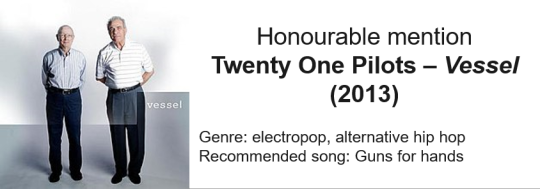
Early 21p may have never aimed to be cool, to avoid a certain appearance of lameness, but they did have a knack for writing some really catchy pop with an optimistic message. To the devoted, the critics of Pilots’ apparent mishmash of nerdy rap, sentimental piano balladry and EDM production were just stuffy, wanting music to stay how it was back-in-the-day forever and unwilling to get with the times. This viewpoint is understandable when you approach this album openly and actually listen to Tyler Joseph’s lyrics about youthful anxiety and insecurity, delivered with real conviction and sincerity, actually recognise that disparate musical elements are all there for emotional punch. A few songs do underwhelm. But this is emo for post-emo Gen Z’s and it’s easy to see why to some it can be deeply affecting.

The musical ancestor to the ongoing and endless stream of ‘lo-fi hip hop beats’ youtube mixes, chillwave filled the same low-stress niche, and Dive released at the peak of the genre’s relevance. Tycho’s woozy, mellow sound prominently features rich acoustic and bass guitar melodies over warm synths, enhancing the music’s organic feel compared to that of purely digital producers in the genre. The experience of starting this album is like waking up in a soft bed, the cover’s gorgeous sunrise reddening the room’s walls, while a guitarist improvises somewhere on the Mediterranean streets outside. And it is indeed great to study or relax to!

Simple, minimal acoustic guitar and vocals. If you’ve got talent this type of music shows it, or else it doesn’t: perfect then for Ichiko Aoba. Her touch is light, her songs calm, meditative, in no rush to get anywhere. As if serenely watching a natural landscape, one can best understand and enjoy Aoba’s music in quiet and peaceful appreciation.
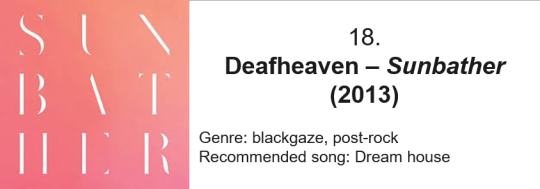
Through the incorporation of genres like shoegaze and alternative rock, Deafheaven managed to create a rare thing: a metal album that’s both heavy and accessible, needing no sacrifice of one for the other’s sake. Over these four main songs, there’s a sensation of being taken on an intense, atmospheric and even emotional journey, with the band stepping away from the negativity and misanthropy that dominates most metal. The vocals, closer to the confessionalism of screamo than classic black metal shrieks, express more sadness than they do aggression, and in respites between solid blaring walls of guitar and drums, calm pianos and gently strummed guitar passages set a pensive tone. This totally enveloping, flawlessly produced sound can take you away, like My Bloody Valentine’s best work, into a dream or trance.

By the late 2000s MCR had taken their thrones as the kings of a subculture formed from the coalition of goth, emo, scene and other assorted Hot Topic-donned kids, and earned a lifelong place in the hearts of many a depressed teenager. But after the generation-defining The Black Parade Gerard Way took off the white facepaint and skeleton costume, ditched the lyrics about corpse brides and vampires, and embraced an anthemic, purely pop punk sound. The silly story of Danger Days, set in a dystopian California where villainous corporations rule and only the Punks can stop them, serves as a kind of idealised setting for the all-out rebellion against authority and normality that so many fantasised about taking part in. The band’s electrifying performances are the most uplifting of their decade making music. For many diehards the upbeat sound here was a celebration that they’d made it through the most difficult years of their lives, and a spit in the face of those who’d done them wrong.

The teller of rural American tales, the indie legend, the teen-whisperer himself. John Darnielle, long past his early lo-fidelity home recordings and now backed by a full band, loses none of the heart his songs are famous for. The theme of the album, taken straight from John’s childhood when the pro wrestling on TV offered an escape from his abusive stepfather, is complemented by the country and Tex-Mex flavouring to the instrumentation. Some of the best lyrics in his long career infuse the stories of wrestlers with universal meaning - his characters try, fail, lose hope, reckon with their mediocrity, and when they step into the ring they’re up against all the adversity life can throw at them. John Darnielle’s saying that when that happens, you stand up and sock back.
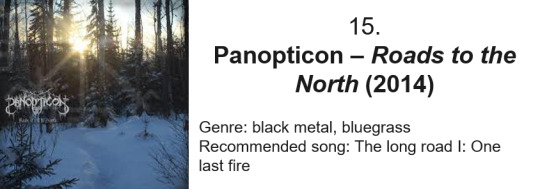
Folk music was always a major part of the Scandinavian black metal scene during its peak years, so when American musicians began exploring the genre naturally they incorporated American styles of folk. The complex, oppressive and sometimes hellish compositions here, starkly contrasted with bluegrass that sounds straight from the campfire circle, give the impression of life in the uncharted woods of the American frontier, in the middle of a brutally cold winter. Almost unbelievably, one-man-band Austin Lunn plays every instrument on the album: multiple guitar parts, bass and drums as well as banjo, fiddle, and woodwinds.
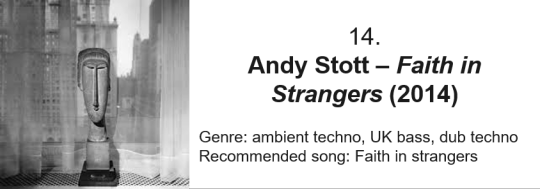
Andy Stott seems to delight in making his music as unnerving, haunting, perhaps even scary, as possible. The female vocals these songs are built around become ghostly, echoing and overlapping themselves disorientingly. The percussion, audibly resembling metal clanging, rustling or rattling in the distance, is often left to stand for its own, creating a tense space it feels like something should be filling. UK-based club and dub music can be felt influencing the grimy almost-but-not-quite danceable rhythms here, but the lo-fi recording and menacing vibe makes this feel like a rave at some sort of dimly lit abandoned factory.

There’s so much Mad Max in this album you can just picture it being set to images of freights burning across the desert. True to its title, the nine songs on Nonagon Infinity roll into each other as if part of one big perpetual composition, with the end looping back seamlessly to the start and musical motifs cropping up both before and after the song they form the base of. With its fuzzy, raw sound, bluesy harmonica and wild whooping, the Gizz create a truly rollicking rock’n’roll experience. The band would go on to release 5 albums within twelve months a year later, but Nonagon shows these seven Australian madmen at the height of their powers.
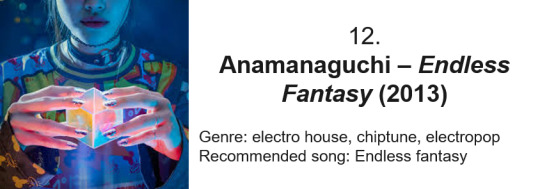
Sometimes you just want to listen to fun, hyperactive pop. The spirit of 8-bit video game soundtracks and snappy pop punk come together to create a vividly digital world of sound that seems to celebrate the worldliness, connectivity and shiny neon colours of early 2010s internet culture and social media. The up-pitched vocals and general auditory mania recall firmly Online musical trends like nightcore and vocaloid, while the beats pulse away, compelling you to dance like this is a house party and the best playlist ever assembled is on. It demands to be listened to at night with headphones, in a room lit only by your laptop screen.
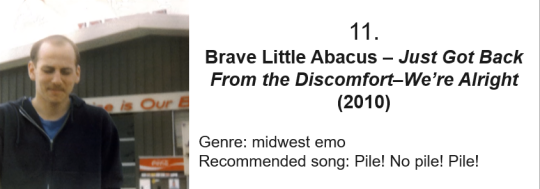
“You hate everyone. To you everyone’s either a moron, or a creep or a poser. Why do you suddenly care about their opinion of you?”
“Because I’m shallow, okay?! … I want them to like me.”
The fact that that Malcolm In The Middle quote is sampled at the emotional climax of this record should give some idea to the absurdity that defines Brave Little Abacus. It’s not even the only sample from the show on here. And yet the passion and urgency so evident in Adam Demirjian’s lispy singing and the band’s nostalgia-inducing, even cozy, melodies are made to stir feelings. The tearjerker chords and guitar progressions are so distinctive of emo bands with that special US-midwest melancholia, and they are interspersed with warm ambiance and playful sound effects ripped from TV and video games, seemingly vintage throwbacks to a sunny childhood. Demirjian’s lyrics, yelled out as if through tears or in the middle of a panic attack, verge on word salad in their abstraction, but that’s not the point: you can feel his small town loneliness and sense the trips he’s spent lost on memory lane. The combined effect all adds to Just Got Back’s themes of adolescence and the trauma of leaving it. While legendary in certain internet communities for this album and their 2009 masterpiece Masked Dancers, the band remains obscure to wider audiences.

These Danish punks know how to convey emotion through their raw and dramatic songs. Elias Rønnenfelt’s vocal presence and charisma cannot be ignored: his husky voice drawls, at times breaks, gasps for breath, builds up the deeply impassioned, intense force behind his words. The band sounds free and wild, unrestrained by a tight adherence to tempo, often speeding up, slowing down or straying from the vocals within the same song, as if playing live. Instrumentally the command over loud and quiet, tension and release, accentuates the vocals in crafting the album’s pace. Horns and saloon pianos throughout give the feel of a performance in a smoky, underground blues bar, with Rønnenfelt swaying onstage as he howls the romantic, distraught, heartbroken lyrics he truly believes in.
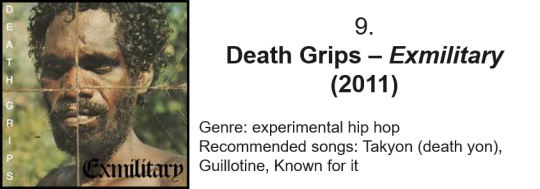
At some point on first listening to Death Grips, a thought along the lines of “He really yells like this the whole way through, huh?” probably crosses the mind. When Exmilitary first appeared, quietly uploaded to the internet, the rapper’s name and identity unknown, another likely reaction among listeners might have been “What am I even listening to?” But perhaps more revolutionary than Death Grips’ incredibly aggressive sound and style might have been its foreshadowing of how over the next decade underground rap acts would explode into the mainstream through viral songs, online word of mouth and memes. It showed all you needed to come from nowhere to the top of the game was to seize attention, and it did that and far more. MC Ride’s intoxicatingly crass, intense rapping captures the energy of a mosh pit where injuries happen, the barrage of sensations of a coke high, while the eclectic mix of rock and glitchy electronics on the instrumentals is disorienting in the best way. If rap were rock and this was 1977, Death Grips would have just invented punk. Ride’s lyrics paint a confrontational, hyper-macho persona; unlike much hip hop braggadocio, the overwhelming impression given is that Ride truly does not care what anyone thinks. He just goes hard and does not stop. It’s music to punch the wall to.
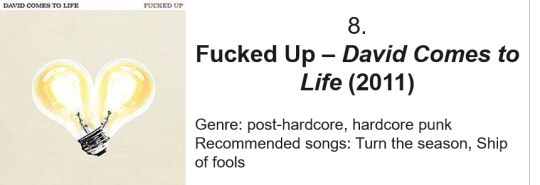
Inspired by classic rock operas, this concept album represents some major ambition and innovation in musical storytelling. Delivered in frontman Damian Abraham’s gravelly shouted vocals, the complex lyrical narrative of the album follows a factory worker, an activist and their struggle against the omnipotent author (Abraham himself) who controls their fates. Featuring devices like unreliable narrators and fourth-wall breaking, it takes some serious reading into to untangle. But it’s the bright guitarwork, combining upbeat punk rock and indie to create some killer riffs, that gives the album its furious energy and cinematic proportions.

Joanna Newsom is enchanted by the past. Like 2006’s ambitious Ys, the music on Divers makes this evident with its invocation of Western classical and medieval music, throwing antiquated instruments like clavichords together with lush string orchestration, woodwinds, organs, folk guitar and Newsom’s signature harp. With her soulful, moving vocals leading the way, it’s hard not to imagine her as some kind of Renaissance-era country woman contemplating nature, love and mortality in the fields and the woods. As always Newsom proves herself a stunningly original and creative arranger with the sheer compositional intricacy and flow of these songs, and most of all the harmonious intertwining of singing and instrumental backing.

Burial’s music is born from the London night: the bustle of the streets, the faint sounds from distant raves, the buskers, the rain on bus windows. This EP’s dreamlike quality makes listening to it feel like taking a trip across the city well after midnight, watching the lights go by, with no idea where you hope to get to. Every single sound and effect on these two songs is so precisely chosen, from the shifting and shuffling beats, the swelling synths and wordless vocals that sound like a club from a different dimension, the ambient hiss and pop of a vinyl record. Musically this sound is drawn from UK-based scenes like 2-step and drum ‘n bass, but twisted into such a moody and abstracted form as to be nearly unrecognisable as dubstep. Just when this urban, dismal sound is at its most oppressive, heavenly soul singers or organs cut through like a ray of light in the dark.
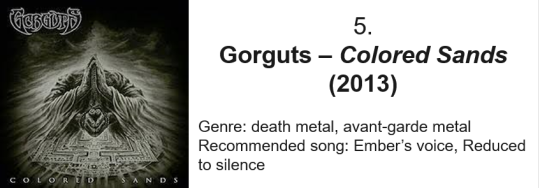
There’s an imaginary rulebook of how construct music, how to properly make tempos and combinations of notes sound harmonious, and Gorguts have spent their career ripping it up and throwing it in the bin. On 1998’s seminal Obscura, their atonal experimentation sounded at times like random noises in random order. But listen closely to Obscura or Colored Sands, their return after a long hiatus, and the method behind the madness emerges. One mark of great death metal is that it’s impossible to predict what direction it will go even a few seconds in advance, and the band achieves this while presenting a heavy, slow, momentous sound. The density of inspired riffs, and the intricate balancing of loud and quiet, fast and slow paced throughout these songs are exceptional. In instrumental sections the guitars will echo out as if across a barren plane, then the song will build up to the momentum of a freight train. Behind the crashing and twisting walls of guitar the patterns of blast beat drumming are almost mathematical in nature. Luc Lemay’s harsh bellows sound like a warlord’s cry or a pure expression of rage to the void. It’s threatening, menacing, unapproachable, but it all makes sense in the end.
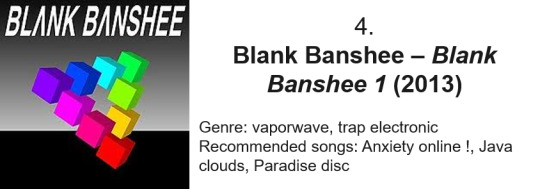
Futuristic yet deeply retro, Blank Banshee’s music takes vaporwave beyond its roots in the pure consumerist parody of artists like Vektroid and James Ferraro and makes it actually sound amazing. Songs are built out of a single vocal snippet processed beyond recognition, new agey synthesisers, Windows XP-era computer noises, hilariously out of place instruments, all set to the 808 bass and hi-hats of hip-hop style beats. The genre’s pioneers intentionally sucked the soul from their music using samples pulled from 70s and 80s elevators, infomercials and corporate lounges - here the throwback seems to be to the early 2000s childhood of the internet, and the influence of a time when email and forums were revolutionary can be felt. The effect of this insanity is an album that whirls by like a techno-psychedelic haze: the atmosphere of dark trap beats places you squarely in a 2013 studio one moment, the next you’re surrounded by relaxing midi pianos and humming that a temple of new age practitioners would meditate to. Still, at some point when listening to this album, perhaps when the ridiculous steel drums kick in near the end, you realise that this is all to some degree a joke, and a funny one. It’s hard to overstate what an entertaining half-hour this thing is.

While 2012’s Good Kid, m.a.a.d City presented a movie in album form of Kendrick’s childhood and early adult years, TPAB’s journey is one of personal growth, introspection, and nuanced examination of the state of race in post-Ferguson America. It’s simultaneously the Zeitgeist for the US in 2015 and a soul-search in the therapist’s office. Sounding deeply vulnerable, he openly discusses depression, alcoholism, religion and feelings of helplessness. The White House and associated gangstas on the cover give some idea to the album’s political themes, with Lamar contrasting Obama’s presidency to the political powerlessness and lifelong ghetto entrapment of millions of black Americans. Everything I’ve written about the lyrics here really only scratches the surface because the words here are substantive, complex and dense with meaning. Near enough every bar can be analysed for multiple meanings and interpretations, essays can and have been written on the overall work, anything less does not do justice. The musical versatility on display is astounding: the album acts as an extravaganza of African-American music, from smooth west coast G-funk to east coast grit, neo-soul and rock to beat poetry, and most of all jazz. Like an expertly laid character arc the record progresses through its ideas in such a way that they’re all impactful, with the slurred rapping imitating a depressed drunken stupor followed later by exuberant, defiant cries of “I love myself!”, the white-hot rage against police brutality balanced by the hopeful mantra: “do you hear me, do you feel me, we gon be alright”. Perhaps the most culturally significant album of the 2010s and an essential piece of the hip-hop canon.
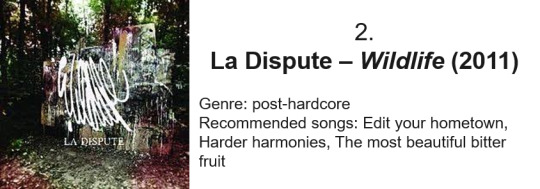
This harrowing hour chronicles the struggles and everyday tragedy of a series of characters and their relationship with the city they live in, narratively driven by some outstandingly poetic lyrics. Jordan Dreyer’s wordy tales despair at the poverty, gang violence and urban decay in the band’s native Grand Rapids, Michigan, an almost childlike open-hearted naivete in his words as he empathises with the broken and alienated people in these songs. There’s no jaded sneer or sly lesson to be learned as he sings about the child killed by a stray bullet or the homebird left alone after all their friends move away, just genuine second-hand sadness and a dream that compassion and community will eventually heal the pain. Taking elements from bands like At the Drive-In’s fusion of punk and progressive, and mewithoutyou’s shout-sung vocals, La Dispute hones its sound to a razor edge to put fierce instrumental power behind the lyrics. Not an easy listen, but a sharply written songbook and a perfect execution on its concept.

Around 2008, Joanna Newsom met comedian Andy Samberg. Within a year, their relationship was becoming the basis upon which the poetry of Have One on Me was spun. Newsom’s lyrics, exploring her relationship with her future-husband, nature, death, spirituality, are above all else loving. Through her warm and vibrant voice, at times an operatic trill and in others deeply soulful, she expresses the joy of love for another, the peace and earthly connection of her beloved pastoral lifestyle, deeply affecting melancholy and grief. Contemplative, artful, genuine or expressive: every lyric in every sweet melody is used to offer her ruminations on life or overflowings of passion.
More so than her previous and next albums, the feel of the album is of not just a folkloric past but also the present day, with drums, substantial brass and string arrangements, and even electric guitar anchoring the sound to Newsom’s real, not imaginary, life in the 21st century. Yet songs here with moods or settings evoking simpler lifestyles and the women living them in 1800s California or the Brontës’ English moors still have a universal relevance. Whether rooted in past of present, the instrumental variety of these compositions, from classical solo piano, grand orchestral arrangements led by harp, to the twang of country guitars or intricate vocal harmonising, makes it apparent that this is the work of a master songwriter in full command of well over a dozen talented musicians. Ultimately, what makes this my favourite album of the decade is that, very simply, it is one stunningly beautiful song after another, all collated into a cohesive 2-hour portrait of Newsom’s soul.
4 notes
·
View notes
Text
What the FAQ?
Why FAQs provide a poor user experience
If your client thinks they need a Frequently Asked Questions page on their website, there’s most likely a problem with their website structure or their content.
FAQs are like the bandaid on a slashed carotid artery. They’re trying to patch a deeper issue but offer no help at all to the gushing wound.
Users should be able to achieve their goal on a website without having to resort to an FAQ page to get the information they need.
It’s unlikely a user is on your client’s website for fun. They’re there because they have to do something (a task-based visit) or find something out (an information-based visit).
By better understanding what your client’s user needs are, you’ll have a clearer idea of how to best serve them and eliminate the need for an FAQ page.
The UK’s Government Digital Service agrees. They don’t recommend FAQs, no longer use them. They advocate for others to ditch them as well.
Why companies love FAQs
Organisations love creating FAQs because they are easy to write in their simple question-answer formula.
FAQs become a lazy catch-all for odd bits of information.
Not sure where this bit of info goes? Let’s put in an FAQ.
Thought of a question one user out of 10,000 might ask one day? Put it in the FAQs.
Had one enquiry about a topic via email that’s specific only to that one person? We took the time to answer them, so let’s add our answer to the FAQ page. Just in case.
Some organisations have trained their users to find their content via the FAQ section. It will be more challenging to convince these organisations to let go of their FAQ pages.
Examples of why FAQs provide a poor user experience
A quick poke around the web and it’s not hard to find examples of FAQs providing a poor user experience.
FAQs that are not even questions
Some organisations write sentences instead of questions, expecting the user to infer what the question is.
Immigration South Australia has a large FAQ section. This is just one part of it. They mix questions and sentences in their FAQ lists.
The not-so-FAQ FAQ
My most-hated FAQ is the FAQ that poses as a thinly veiled vehicle for self-promotion. You know the ones that read something like ‘How can I tell all my friends about your exceptional product?’
I’ll tell you exactly how many people asked that question. Zero.
If your client has these kinds of FAQs, get rid of them.
Here’s an example of a not-so-FAQ FAQ from Urban Home.
The problem with FAQs
One of the reasons why FAQs provide a poor user experience is that they quickly grow from a manageable handful to 15 to 30 to 63.
Before you know it, the dumping ground is a disorganised mess where a user must sift through dozens of FAQs that are of no relevance to their question.
Or the questions are so specific that your user can’t identify their problem among the FAQs.
This, apparently, is a frequently asked question. It’s on the ATO website.
This is an example of when FAQs become so trivial and specific to a single person they don’t cover important information relevant to most site visitors.
Heading length and FAQs
Another problem with FAQs is that FAQ headings are often longer than standard headings.
For example:
How do I get the stun feature on my Zombie Zapper 2.0 to work?
When users scan your page, they look at the first few words of headings.
So, if you have ‘How do I get the …’ as your first few words, your users are missing the key words about the stun feature on their Zombie Zapper 2.0 when they scan your content.
Instead, a heading like this works better:
Using the stun feature on your Zombie Zapper 2.0
Here’s another example of a dog’s breakfast of FAQs, courtesy of our federal government’s FAQs on the Australian Parliament House website.
FAQs on mobile phone screens
These headings are not optimised for scanning. Some of their FAQs are far too long and wrap across 2 or more lines on a mobile phone.
This is what the same FAQ list looks like a mobile phone screen.
It’s not a pleasant user experience.
Action-oriented headings
Starting headings with a verb makes them action-oriented and more engaging. Users are more likely to see their key words as they scan your page.
Short headings also work better on mobiles.
If this wasn’t an FAQ page, the headings would be more like:
Contact your local member
Learn what work the House does
Get your petition before the House
House sitting times
Standing and sessional orders
FAQ alternatives
If FAQs are so bad, what can we do instead of creating an FAQ page?
We can make sure the website’s information architecture (IA), is giving users the right cues to help them find the information they need. (A website’s IA is the labels we assign to menu topics.)
You can move FAQs onto the relevant web pages.
To make sure you’re only moving relevant and appropriate content, start this process with an FAQ audit.
Audit the FAQs
Gather a list of all the FAQs. My preference is to do this in a spreadsheet and identify:
the user need
the topic it most relates to
location of where the info belongs on the website
if it’s duplicated or already answered in the content
if it’s a true frequently asked question or if you can cull it
Move FAQ content into the relevant web pages
Map the FAQ content you’ll keep to the relevant page on the website.
Check if the page already addresses that question. If it does, there’s no need to add the FAQ content.
The only reason to include an FAQ format on this page is to address the SEO benefits through keyword targeting. We’ll cover this in more detail further on.
Test the IA
When a client’s site is undergoing a redevelopment, it’s the perfect time to assess the need for their existing FAQ page.
The new IA should capture the most likely place for the FAQs.
I use Treejack by Optimal Workshop to test IAs. Upload your menu headings, set user tasks, recruit users to complete those tasks. You’ll soon figure what’s working and what’s not working well with your menu design.
I’ve over-simplified IA testing, but that’s a whole new topic in itself.
*Adds IA testing to list of blog posts to write*
Set strict rules around the creation of new FAQs
Just because someone asked a question once back in 2017, it doesn’t build a business case for the website to include it.
So, what does?
Call centre staff, especially if they log call data, are a brilliant source of data. Sales staff also know the main objections and questions potential customers have about a product or service.
There are no definitive criteria for FAQ governance, you can set the criteria with your client. Consider if frequently asked questions:
are true FAQs
have evidence to back up that they are an FAQ
are not self-promotion
have already been answered in the page content
highlight a flaw in the site’s IA
need further user testing
are keywords that need to be included for SEO purposes
When FAQs work well
In most situations, if you or your client thinks you need an FAQ page, the content or menu structure isn’t doing its job well.
I hate blanket rules — that’s why I say ‘most’ situations.
There are a few situations where FAQs can work well. For example, they can work well:
When you have a transaction-based eCommerce site and need to cover shipping and returns information.
For an event or conference that has a lot of details about the logistics of the event.
For a sales page where you can use the FAQ format to counter objections. You also want to keep the user on the sales page, rather than sending them elsewhere to find the information. You might lose their attention during the sales process if you send them elsewhere to find the information they need.
But for everything else, let’s ditch the FAQ page and incorporate the information into the relevant place on the website.
FAQs and their impact on SEO
With the rise of voice search and the valuable real estate of search engine results pages up for grabs with rich snippets, questions and their answers have become an important component to include in your web content.
I’m not saying no to FAQs full stop. I’m saying no to FAQ pages and FAQs as a main menu heading (unless you’re ultra-specific – like the ‘Shipping FAQs’ for an eCommerce store).
But ditch the standalone FAQ page.
One of the last major Google algorithm updates was about relevance.
An FAQ page with loads of questions and answers across a broad range of topics will most likely not satisfy Google’s thirst for relevance.
You’re better off building the credibility, authority and relevance of a single page. Add the FAQ keyword to the core, pillar page. Don’t add the keyword to an FAQ page where you’ll be sending mixed signals and cues to search engines and diluting the value of the keyword for your site.
And when was the last time you remember stumbling across an FAQ page via a search engine?
The FAQ challenge
Is there an FAQ page or *gulp* an entire FAQ section on your client’s website you could disassemble and disseminate the information to specific pages in the right context?
What the FAQ? was originally published on Sandra Muller
0 notes
Text
Managing Wealth
With markets riding high and uncertainty growing, wealth management matters more than ever. Six experts offer their views on all things wealth related
The Experts
Gautam Duggal, Regional Head of Wealth Management for Africa, the Middle East and Europe – Head of Wealth Management for the UAE, Standard Chartered Bank
Frederic Hilal, Head of Wealth Management in the Gulf region (excluding Saudi Arabia), Deutsche Bank
Dr. Ryan Lemand, Managing Director – Head of Wealth Management, ADSS
Marwan Mohad Hadi, Head of Retail Banking and Wealth Management, HSBC UAE
Dr. Niels Zilkens, Head of Wealth Management Arabian Gulf (ME) and NRI (Non Resident Indians) at UBS Global Wealth Management
Steve Weller, CEO, Saxo Bank MENA Region
What trends are you seeing in terms of demand for personal finance services and wealth management, especially with respect to high net-worth individuals?
Duggal: The trends vary depending on the client segment and market. HNWIs are generally particular on service rather than prices. The nature of the service they demand varies from one location to another, or even from one client to another. However, a majority of them would seek advice on technical aspects of planning, such as portfolio performance and estate planning. They are generally less price sensitive and do not mind paying more to be served better. Certainly, there is a demand for going beyond just managing wealth, for example in some locations banks are running education programmes for the children of HNWI to ensure they are equipped to manage their financial affairs in the future.
Gautam Duggal, Standard Chartered Bank
For the mass-affluent market on the other hand, the trend is about the commoditisation of products and reduction of costs. Most of them are keen to interact or transact digitally especially the young mass-affluent or emerging-affluent clients. Every institution is closely looking at its clients to see what auxiliary services they can offer them.
Hilal: With regards to UHNWI, we are seeing more and more demand for geographical diversification. Clients, through their family offices (FOs), are looking at real estate opportunities in Europe and the U.S. Historically, the most attractive market for Middle Eastern clients has been the United Kingdom. This remains the case followed by markets like Germany and the United States. Clients are looking at both residential and commercial opportunities, without distinction, with yield being their primary targets.
On the wealth management side, clients are looking at diversification away from the local markets in the form of discretionary portfolio mandates.
Mohad Hadi: The demand varies individually but there is an evident trend where the type of transaction is driving the choice of channel. Simpler, everyday products such as credit cards or small loans are increasingly being bought online. More complex products, or where there is a large financial commitment, such as a mortgage or large Investments, clients will initially search online but still wish to sit and meet a qualified adviser before putting pen to paper.
Lemand: The trends are geographical and asset based. We are seeing HNW and UHNW investors looking at running all or part of their portfolios out of new financial centres to work under jurisdictions which have firm but fair regulation. They are also looking to diversify their investments so that they can reduce their correlation with the main markets. This de-risking of investments is closely linked to geopolitical uncertainty which, at the moment, is focused on the trade stance adopted by the Trump administration in the US.
Weller: One of the trends we are observing is strong interest in managed investments. Investing in a managed portfolio with diversification can be a wise choice for people without the time or motivation to pick stocks or other investments for their own portfolios.
How is the current state of the world economy affecting wealth management?
Lemand: The main markets have effectively been on a nine-year bull run. This is raising many flags as the run is being fuelled by tech stocks. Most investors, although they are not looking for a crash, believe that the momentum has to end. The recent volatility over Facebook shares shows that the tech bubble may soon be heading for a correction. For this reason they are diversifying into new markets and different asset classes.
Zilkens: With rising markets over the last few years, a lot of our clients have certainly become much wealthier, although some of them feel that the end of this cycle is near. We disagree with this view; yes, we are at the later stage of the economic cycle but we are not yet close to its end.
Duggal: We expect global growth to remain positive. Our Global Investment Committee assigns a 65% probability to a scenario of moderate to strong growth with limited inflation unfolding in the next 12 months. We continue to expect global growth to remain resilient in spite of rising US protectionism and increased fragility within the Euro area. Trade tensions are a key risk, which could exacerbate inflationary pressures in the near term. That said, our central scenario is for trade tensions to ease in the coming months.
Mohad Hadi: Equities are a long term investment and investors may want to consider an allocation to this asset class within their portfolio for long term capital growth objectives. It may well be that current US equity valuations are overvalued but the expectation is that proposed tax cuts and pro-business government policies are driving higher growth as seen by the latest US GDP numbers.
Frederic Hilal, Deutsche Bank
Is there a growing appetite for risk to achieve higher returns?
Lemand: In the world of HNW and UHNW investors we are dealing with individuals and family offices which are looking to preserve capital and maintain wealth, often for future generations. This means that they have very specific requirements and will spread risk very carefully. They may have some very high return investments, but these are carefully balanced.
Zilkens: Risk appetite is usually a function of individual preferences, the overall financial situation of the client – the level of overall wealth, where we stand in the economic cycle, etcetera. We assess these factors very thoroughly with each and every client which then forms the basis of our investment discussion.
Duggal: The short answer is yes. With the rise in interest rates, clients have started allocating more towards equities. From last year we have also seen increased appetite for emerging market equities besides the traditional affinity for US equities which still remains quite strong. We recommend diversified portfolios for clients with a bullish equity stance.
Hilal: We have seen risk appetite decrease over the past 12-18 months. Clients, through their FOs, have a disciplined approach to investment. We most often see a very solid core investment, complemented by a smaller tactical approach to wealth management.
How is the situation in the GCC? Are high net worth individuals making similar decisions to people in Western markets?
Marwan Mohad Hadi, HSBC UAE
Hilal: The situation in the GCC has obviously been much more challenging in the past 18 months. The challenges are both economical and geopolitical. Contrary to previous periods though, our clients are much more diversified geographically. This in turn has allowed them to weather the storm and keep their investment strategies intact.
Mohad Hadi: As oil prices recover regional HNW investors may potentially be open to exploring investment opportunities further afield. The thirst for yield continues but diversification appears to be equally important. Hence the usage of multi-asset strategies continues to gather pace. Alternative investment strategies such as hedge funds, private equity, trade finance and infrastructure debt are also finding traction with regional investors.
Duggal: Clients based in the GCC have conventionally had a preference for income oriented solutions with predictable cash flows. In recent times in particular, the negative cash flows accruing from a protracted low oil price environment had led investors towards shorter duration, cash like investments with a focus on yield enhancement rather than on total returns. However, with oil prices stabilising at reasonable levels, GCC HNIs have greater confidence now in taking on meaningful risks in their investment portfolios.
Zilkens: Most of our clients who reside in the GCC have significant investments in the local markets – be it in the real estate sector or in the local stock markets. From my personal experience in dealing with clients from the GCC region, I believe they tend to prefer coupon bearing investments like fixed-income while their Western counterparts favour equity investments. What is clear – high net worth individuals are staying invested across all markets.
Dr Ryan Lemand, ADSS
Lemand: In simple terms, yes. They are cross-asset and cross-market and looking to develop diversified portfolios which provide a range of returns. There is still a focus on the main markets and historically strong sectors such as banking, and regionally many people still like to hold gold and real estate, but in general they assess each investment on its own merit.
Are customers looking to take more control of their finances?
Hilal: Our clients are typically UHNWI with very sophisticated FOs, staffed with professionals with years of experience in managing wealth in various market conditions. As such, the FO has taken much more control of the investment decisions and have created a disciplined approach to asset allocation and product selection. This in turn requires us to treat our counter-parties on a semi-institutional basis rather than a retail one.
Duggal: A certain number of our clients are busy running their business or hold demanding jobs; for them staying on top of markets may not be the most efficient use of their time or may be beyond their expertise. Some such clients prefer to focus on what they do best which is to earn money using the skills they have built over a time and depend on financial specialists significantly for advice and managing their finances. However, with the advancement of technology, information is now available at the client’s fingertips. Many of our clients closely follow the markets and this has certainly been made easier by technology.
Lemand: We are finding that the level of sophistication of investors is increasing all the time and they need access to be able to monitor and, if required, manage their own accounts.
How is technology affecting wealth management?
Weller: Technology is affecting wealth management in many positive ways such as ensuring better pricing and speed of execution, but beyond that one of the greatest advantages I believe is the improved transparency in investments. Through digital innovation it is entirely possible – even essential – to be aware of all that is going on with your investments.
Duggal: Technology is affecting all industries and wealth management is no exception. We do not see technology as a threat but we see it as an opportunity and a tool that will allow us to better serve our clients. The technology will continue to grow in numbers and increase its significance, but the human element will still play a crucial role in this business. Most of us are probably not yet comfortable going into the operating room and having a fully automated robot conduct a surgery on us, and in the same sense we are not ready to fully hand over our financial health to the machines.
Hilal: Technology is at the very core of wealth management. First and foremost, our clients and their FOs, expect from Deutsche Bank the latest in technology to allow them to manage their accounts on a daily basis, wherever they are in the world. From mobile applications to robust access to information (statements, news, research, CIO views, etc.), technology makes the client experience a positive one. Second and as important, technology makes our employees much more efficient. This in turns allows our employees to become much more productive and free up their time to spend more time listening to their clients.
The post Managing Wealth appeared first on Bloomberg Businessweek Middle East.
from WordPress https://ift.tt/2P38qV4
via IFTTT
0 notes